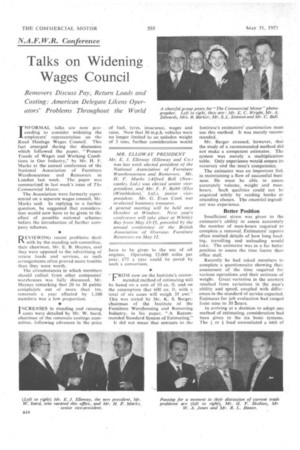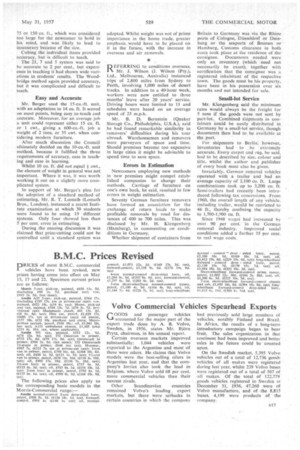N.A.F.W.R. Conference
Page 48

Page 49

If you've noticed an error in this article please click here to report it so we can fix it.
Talks on Widening Wages Council
Removers Discuss Pay, Return Loads and Costing: American Delegate Likens Operators' Problems Throughout the World
INFORMAL talks are now proceeding to consider widening the employers' representation on the Road Haulage Wages Council. This fact emerged during the discussion which followed the paper_ "Present Trends of Wages and Working Conditions in Our Industry," by Mr. H. E. Marks at the annual conference of the National Association of Furniture Warehousemen and Removers in London last week. The paper was summarized in last week's issue of The Commercial Motor.
The Association were formerly represented on a separate wages council, Mr. Marks said. In replying to a further question, he suggested that consideration would now have to be given to the effect of possible national schemes before the introduction of further company schemes.
po EVIEWINC_I recent problems dealt 1 x with by the standing sub-committee, their chairman, Mr. E. B. Haynes, said they were opposed to the advertising of return loads and services, as such arrangements often proved more trouble than they were worth.
The circumstances in which members should collect from other companies' warehouses was fully discussed, Mr. Haynes remarking that 20 to 30 public complaints out of more than 1m. removals a year effected by 1,100 members was a low proportion.
INCREASES in standing and running 1 costs were detailed by Mr. W. Isard, chairman of the removals costings committee, following advances in the price
of fuel, tyres, insurance, wages and rates. Now that 30 m.p.h. vehicles were no longer limited to an unladen weight of 3. tons, further consideration would
have to be given to the use of oil engines. Operating 12,000 miles per year. £75 a year could be saved by such a conversion.
FROM now on the Institute's recom
1 mended method of estimating will be based on a unit of 10 cu. ft. and on the assumption that 600 cu. ft. with a total of six cases will weigh 35 cwt..' This was stated by Mr. K. S. Berger, chairman of the Institute of the Furniture Warehousing and Removing Industry, in his paper, " A Recommended Standard System of Estimating."
It did not mean that entrants to the Institute's estimators' examination must use this method. It was merely recommended.
Mr. Berger stressed, however, that the study of a recommended method did not make a competent estimator. The system was merely a multiplication table. Only experience would ensure its accuracy and the man's competerice.
The estimator was an important link in maintaining a flow of successful business. He must be able to assess accurately volume, weight and manhours. Such qualities could not be acquired solely by reading books or attending classes. The essential ingredient was experience,
Better Position
Insufficient stress was given to the estimator's ability to assess accurately the number of man-hours required to complete a removal. Estimators' reports often omitted details of how long loading, travelling and unloading would take. The estimator was in a far better position to assess the time factor than office staff.
Recently he had asked members to complete a questionnaire showing then assessment of the time required for • various operations and their estimate of weight. Great variation in the answeis resulted from variations in the men's ability and speed, coupled with differences in the standard of service expected. Estimates for job evaluation had ranged from nine to 30 t ours.
In arriving at a decision to adopt one method of estimating, consideration had been given to the six basic systems. The I or * load necessitated a unit of 75 or 150 cu. ft., which was considered too large for the newcomer to hold in his mind, and was likely to lead to inaccuracy because of the size.
Cubing the individual items provided accuracy, but is difficult to teach.
The 21, 7 and 5 system was said to be accurate to 2 per cent., but experience in teaching it had shown wide variations in students' results. The Woodbridge method again provided accuracy, but it was complicated and difficult to teach.
Easy and Accurate
Mr. Berger used the 15-cu.-ft. unit, with an adaptation to 14 cu. ft. It scored on most points, being easy to-teach and accurate. Moreover, for an average job a unit could represent either 15 cu. ft. or I cwt., giving a 600-cu.-ft. job a weight of 2 tons, or 35 cwt. when considering modern furniture.
After much discussion the Council ultimately decided on the 10-cu.-ft. unit method, because it fulfilled the three requirements of accuracy, ease in teaching and ease in learning.
Whilst 10 cu. ft. did not ,equal cwt., the element of weight in general was not important. Where it was, it was worth working it out on a slightly more complicated system.
In support of Mr. Berger's plea for the adoption of a standard method of estimating, Mr. R. T. Lomath (Lomath Bros., London), instanced a recent Institute examination at which 30 students were found to be using 19 different systems. Only four showed less than 5 per cent. error in estimating.
During the ensuing discussion it was claimed that price-cutting could not be controlled until a standard system was adopted. Whilst weight was not of prime importance in the home trade, greater emphasis would have to be placed on it in the future, with the increase in overseas and air removals.
REFERRING to conditions overseas, I Mr. J. Wilson (J. Wilson (Pty.), Ltd., Melbourne, Australia) instanced trips of 2,800 miles from Sydney to Perth, involving 1,000 miles of desert tracks. In addition to a 40-hour week, workers were now entitled to three months' leave after 20 years' service. Driving hours were limited to 11 and schedules were based on an average speed of 25 m.p.h.
Mr. B. D. Bernstein (Quaker Storage Co., Philadelphia, U.S.A.), said he had found remarkable similarity in removers' difficulties during his tour abroad. Warehousemen and removers were purveyors of space and time. Should premises become too expensive in large cities it might be advisable to spend time to save space.
Errors in Estimation
Newcomers employing new methods in new premises might compel established companies to change their methods. Carriage of furniture on one's own back, he said, resulted in few errors in weight estimation.
Seventy German furniture removers have formed an association for the exchange of return loads to make profitable removals by road for distances of 400 to 700 miles. This was disclosed by Mr. H. Klengen berg (Hamburg), in commenting on condiditions in Germany.
Whether shipment of containers from Britain to Germany was via the Rhine ports of Cologne, Dusseldorf or Duisburg or the seaports of Bremen or Hamburg, Customs clearance in both cases took place at the residence of the consignee. Documents needed were only an inventory (which need not necessarily be exact), together with certification that the consignee was a registered inhabitant of the respective town. The goods must be his property, have been in his possession over six months and not intended for sale.
Small-lot Service
Mr. Klengenberg said the minimum rates would always be the freight for 5 tons if the goods were not sent by part-lot. Combined s'aipments in containers could be easily distributed in Germany by a small-lot service, though documents then had to bp available at the port.
For shipments to Berlin, however, inventories had to be extremely accurate. Every carpet and rug, he said, had to be described by size, colour and title, whilst the author and publisher of every book must also be given.
Invariably. German removal vehicles operated with a trailer and had an average capacity of 2,100 cu. ft. Large combinations took up to 3,200 Cu. ft. Semi-trailers had recently been introduced following tax concessions. From 1960, the overall length of any vehicle, including trailer, would be restricted to 46 ft., thereby confining the capacity to 1,700-1,900 cu. ft.
Since 1948 wages had increased by over 90 per cent. in the German removal industry. Improved social conditions added a further 35 per cent. to real wage costs.




































































































